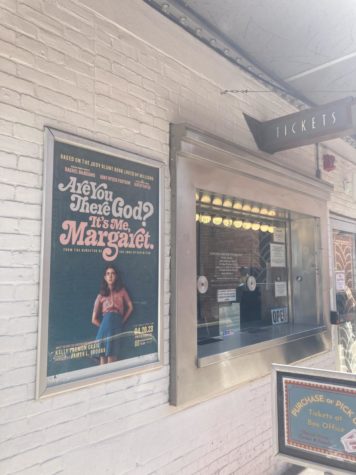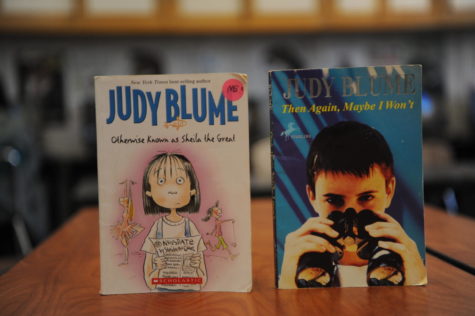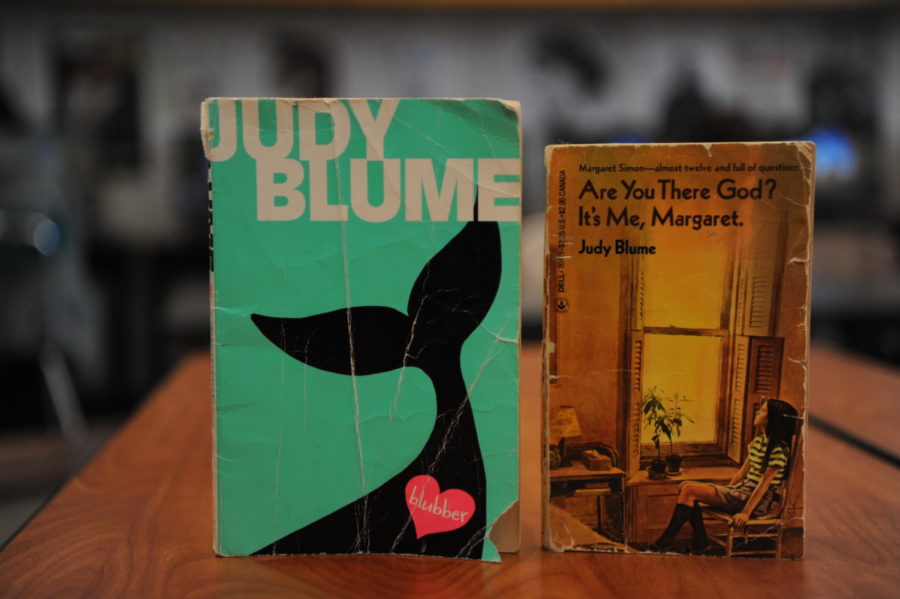What Judy Blume Means to Gen-Z
Her quintessential coming-of-age books have raised generations of American kids, teaching lessons about identity, family, and development. Yet does Gen-Z, coming of age in a digitized, modern new world connect with Judy Blume’s work the same way?
Here are Judy Blume’s ‘Blubber’ and ‘Are You There God? It’s Me, Margaret,’ the exact copy that was my mother’s.
An age of rotary phones, Bing Crosby, and going steady. A time when unaccompanied fourth graders roamed New York City streets and high school seniors only applied to three colleges. An age foreign to the Instagramming, modern, Gen-Z teenager.
For decades, Judy Blume’s novels have helped raise generations of young adolescents. From humiliations in elementary school bathrooms to sleepovers with whispers and giggles, Judy Blume’s novels delve into sex, love, religion, puberty, and identity with wry humor, and real emotion. Her characters are uniquely relatable and so lifelike that they often serve as friends to the teens and tweens making their way in the world.
Her famed novels, at one point read by nearly every kid in the country, made Judy Blume a cultural icon of the 70s and 80s. Now, Blume, at 85 years old, seems to be having a resurgence, with widespread public interest in her life, work, and legacy. But is Gen-Z paying attention? Does Judy Blume mean the same thing to today’s teenagers that she did for their parents?
In the past few months, Judy Blume has been in the spotlight. A movie adaptation of Blume’s 1970 novel Are You There God? It’s Me, Margaret was released in theaters in April 2023 and is now available for streaming. Forever, a documentary exploring Blume’s life and legacy began streaming on Amazon Prime Video this spring.
This is only the beginning, with more media adaptations on the horizon. From a Netflix series based on Forever, a Superfudge animated movie coming to Disney+, and even plans to develop Summer Sisters, one of Blume’s adult novels, into a TV show. Blume was named on the 2023 TIME 100 list, and The New York Times published a page entitled “The Judy Blume Renaissance” with reviews of recent movies, an interview with Blume, and a recommendation of must-reads.
Blume has also been trending in the media regarding new waves of book bans directed her way. Since the 1970s, Blume’s books have been censored by parents associations and school districts, for covering adult topics in works targeted at adolescents. In 2022 book bans reached a record high, and Blume’s work has yet again come under fire from conservatives for inappropriate content.
While Blume’s longtime fans are following her every move, Gen-Z audiences don’t have the same relationship with Blume. While many Bronx Science students seem to have heard of the bestselling author when questioned on specific books they have read or even a general impression of Blume’s work most had little to say.
Dara Reisner ‘25 simply said, “Who is that?” when asked if she read Judy Blume. Dozens of others were confused about who Blume was or what she had written, while others knew of her but replied with an apathetic tone.
I saw the Are you There God it’s Me, Margaret movie recently with my mother and grandma. Ever since we heard word of the adaptation, my mom and I had talked excitedly about our plans to see it together in theaters when it came out. Margaret meant a lot to us. The copy of the book I read while in elementary school had once belonged to her, and is printed with a Scarsdale Elementary School stamp in the inside cover (my mother claims “not to remember” whether she stole the book). My own fondness of Judy Blume comes entirely from my mother’s childhood connection; connecting with Blume is a way of connecting with her, the girl she once was.

For my mom, the movie felt warmly familiar. The dress Margaret wears on her first day of sixth grade, a collared, plaid school dress with a bow at the collar, reminded my mom of unboxing hand-me-downs from her older cousins. She remembered talking on the corded telephone and shopping at the type of department store where Margaret buys her first bra. When my mom read Margaret, it was the story of her own girlhood. Driving back from the movie theater, she said she had trouble distinguishing between what had actually happened to her and what had happened in the book. Her memories of her own suburban girlhood and the world depicted in the novel had virtually merged in her mind. For my mom, Judy Blume and childhood were synonymous.
When my mom was a kid, Judy Blume’s work was revolutionary – topics like menstruation and religious identity, amongst others, were historically taboo. Judy Blume’s work allowed young people to come to grips with fears, questions and yearnings that were otherwise considered forbidden territory, opening up the opportunity for open discussion and exploration. In the landscape of 1970s media, before the term young adult even existed as a category, Judy Blume stood alone.
Margaret isn’t the only example. My mother’s favorite Judy Blume books each offered a window into a world that was nearby, yet otherwise off limits. Starring Sally J. Freedman as Herself uniquely told the story of a story of girl in America, worrying about the Holocaust from afar. It was the only book that my mother knew of that covered such a topic. Deenie explored the self-consciousness of a teen confronting scoliosis, offering a window into the vanities and insecurities of a teenager dealing with being different.
These path-breaking books opened up entirely new terrain for an entire generation of readers. Lisa Elkin, mother to a Bronx Science tenth grader, said, “We felt like they were mature, like you were getting a window into something that was going to happen. I remember we passed the book around – Forever. It was like an underground book with worn and dog-eared pages. We even knew the page numbers to turn to with the sex parts.”
In a sense, Blume was the first to usher in the modern age, filled with books about all kinds of people and previously off-limits topics. Sex, identity, disability, and body image gradually came to be topics that would flood the modern media. With social media, movies and TV shows, and even the swarm of activist movements, Gen-Z has grown up in a world saturated with explorations of every facet of adolescence.
With the rise of streaming and adolescents owning their own devices, media consumption has increased drastically. Topics explored in the Blume book, Are You There God, which feature instructions on how to prepare for your first period or whether its possible to increase your bra size, are now the subject of countless TikToks, Youtube videos and Instagram posts and don’t require actually reading a book. What was once considered edgy content now comes across as innocent. Books and television shows aimed at teen audiences now cover issues like drugs, drinking, violence, pregnancy, racism and other subjects that Blume scarcely touched. A study published in the Journal of Adolescent Health found that film, television, music and magazines can serve as a “sexual super peer.” The media they consume provides information, whether adolescents seek it out or not.
From sitcoms with raunchy jokes to popular dramas like Gossip Girl or Euphoria, many kids start consuming “adult” media at much younger ages. Christine Woods ’25 said, “I also think coming of age, and teen T.V. shows played a big part in learning about sex and puberty.” She also noted the influence of social media. “I think I learned a lot at that age through YouTube. There were a lot of young influencers who talked about things like that, and that’s how I became familiar with it.
Another reason these books are less read or appreciated among Gen-Z may be because our attention span has shortened. With Tik Tok providing endless scrolling and instant gratification, people have less time to appreciate gentler, slower pleasures. Books and TV shows are full of scandal and endless drama. Teen shows are full of affairs and fights, movies with disasters and confrontations. What seems to sell these days are the twists and turns, the unexpected, the shocking. Harry Potter and Percy Jackson are filled with gods and magic. By comparison, Judy Blume’s work contains little that’s shocking. Instead it paints the real pictures of life, funny, sad, and relatable.
My own connection to Judy Blume is not the same as my mother’s. Certain aspects of the world she depicts are very foreign: the boy-girl party in one kid’s basement, receiving letters in the mail or the old-fashioned cars. Instead of representing an edgy exposé of forbidden topics, Judy Blume’s work now comes across as charmingly nostalgic. It is a world of girlhood and simplicity, free of cell phones or helicopter parents. One where kids go under backyard sprinklers instead of visiting mammoth water parks. In the movie, Margaret’s mother mentions that she is late coming home from school. Her mother isn’t concerned, calling isn’t an option so she simply waits. Judy Blume’s books contain no school shootings, nothing that warrants a trigger warning, and no hours lost to obsessing over curating an Instagram feed. What was once a portal to a more open-minded and sophisticated world is now a path back to a more innocent time. What was once revolutionary is now nostalgic.
No matter your generation, certain aspects of Blume’s books are transcendent. Her sharp rendering of the smallest, most universal moments of life offers a reminder that whether you’ve grown up in the 1970s or 2020s, certain fears, wishes and needs are unchanged. The dreamy face Margaret makes after a boy kisses her for the first time; her fervent waiting and hoping for her first period. They distill these characters to their very core, and as such you get to know them on a deeper level. Whether you’re 56 or 16 you can understand Margaret, Sally, Katherine, and Jill.

The appeal of Blume’s work is not lost to the past. It is simply different. I can relate to Margaret and her friends not because our day-to-day life is similar, but because the themes of girlhood and childhood are enduring. Margaret is a story of yearning. Yearning for her first period, her first kiss, to see her body mature and know that she, too, will grow up. While my wants and wishes may be slightly different, the experience of craving them is very much the same. In Forever, Katherine grapples with deciding what she’s ready for sexually, a question teens all ask themselves. It is a story about how apprehension and excitement intersect, a universal experience.
These themes span time, and span generations. After my grandmother saw the movie, she felt reminded of her own life, and related to Margaret even more than to Margaret’s mother, who would have been from her generation. She remembers learning about periods and things from her girlfriends and being mortified when her mother tried to sit her down and talk about it, my grandmother telling her mom that she already knew everything to be said.
While these books may not hold up a mirror to my own modern, digital life, they offer a window into a world inhabited by girls just like me. And a reminder that me, my mom and my grandmother all have that same girl somewhere inside us.
“We felt like they were mature, like you were getting a window into something that was going to happen. I remember we passed the book around – Forever. It was like an underground book with worn and dog-eared pages. We even knew the page numbers to turn to with the sex parts” said Lisa Elkin, mother of a Bronx Science 10th grader.
Liza Greenberg is a Managing Editor and Advisory Editor for ‘The Science Survey.’ She is responsible for editing and her classmates' articles, and...











